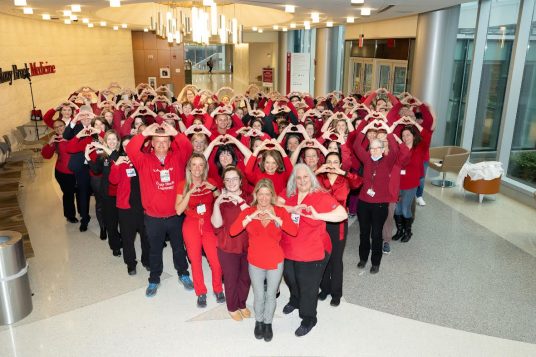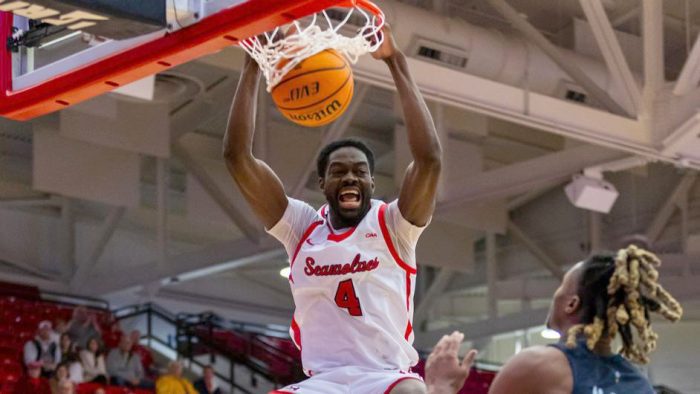Today is Wear Red Day, supporting the American Heart Association’s “Go Red for Women” movement, which raises awareness about cardiovascular disease in women. And in honor of the nationwide movement, Stony Brook Medicine rocked their red gear to make a heart of their own during American Heart Month. Each year millions of people unite for a common goal: the eradication of heart disease and stroke.
SBU’s Oliver Shipley identifies new creature in deep Bahama waters
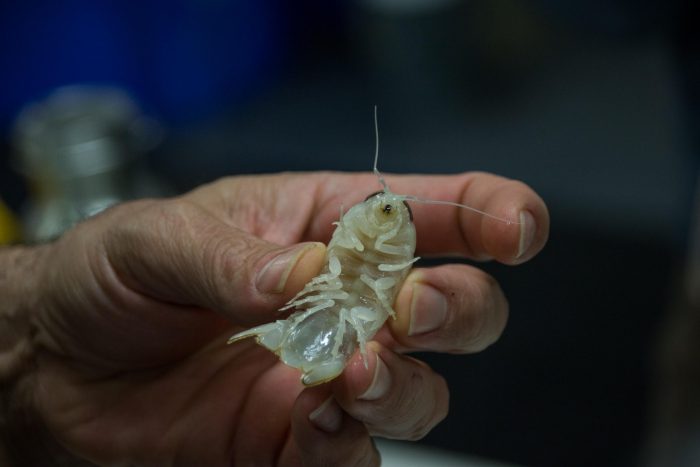
By Daniel Dunaief
Oliver Shipley recently shared one of the mysteries of the heavily photographed but lightly explored deep sea areas near the Bahamas’ Exuma Sound.
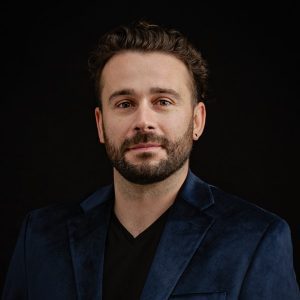
A Research Assistant Professor at Stony Brook University, Shipley and his colleagues published a paper in the journal Zootaxa describing a new species of isopod they named Booralana nickorum.
A few inches long, this isopod, which was found at a depth of about 1,600 feet, sheds light on some of the mysteries in these waters, offering a glimpse into areas mostly too deep for sunlight to penetrate.
“The level of knowledge on deep sea biodiversity anywhere in the Caribbean is very poor,” said Shipley. The scientists were specifically studying the biomass housed areas around The Exuma Sound.
In the Bahamas, the researchers are interested in preserving species biodiversity and identifying links between the shallow and deep-sea ecosystems, which can inform management of marine resources and help conserve biodiversity.
Shipley suggested it was “exciting” and, perhaps, promising that this area has already produced two isopods that are new species, both of which he described with low-cost technologies deployed off small boats.
“We haven’t even genetically sequenced 95 percent of the creatures that we’ve captured” which includes fish and sharks, Shipley said.
Brendan Talwar, a co-author on the paper describing the isopod and a Postdoctoral Scholar at Scripps Institution of Oceanography at UC San Diego, added that “this discovery is representative of the lack of knowledge” in this area. “You can swim from one environment, where almost every species is known or has been studied, to a place where almost nothing is known and almost nothing is studied.”
Finding new species could have numerous benefits, including in the world of drug discovery. To be sure, such findings require “many years of work and analysis” he said.
Still, such a possibility for future benefits exist, particularly as researchers catalog and study these creatures.
In the meantime, understanding individual species and the ecosystems in which they live can reveal information about how, depending on the biomass of various species, different places affect the cycling of gases such as carbon dioxide.
“When you find high biomass of a new species, it could have potentially huge implications for mitigating climate change,” said Shipley. “We have a primitive understanding of the Caribbean deep sea ecosystem. We don’t know the full effects or benefits and services of organisms that live in the deep ocean environment.”
In addition to finding organisms that might provide various benefits, scientists are also hoping to understand the “food web dynamics of the eastern Bahamas,” said Talwar.
Long road to identification
Shipley first saw an individual of this isopod species in 2013. Over time, he has since identified numerous other individuals.

The region in which Shipley identified this isopod has several potential food or energy sources. The deep sea area is in close proximity to shallower sea grass beds, which are closer to the surface and use light to generate food and energy through photosynthesis.
The tides and currents wash that sea grass into the deeper territory, sending food towards the deeper, darker ocean.
Energy also likely comes from coral reef productivity as reefs line the edge of the drop off.
Additionally, animals that traverse the shallower and deeper areas, whose poop and bodies sink, can provide food sources to the ecosystem below.
“There may be multiple sources of productivity which combines to promote a high level of biodiversity” in the ecosystem below, said Shipley.
The isopod Shipley and his collaborators identified lives in a pressure that is about 52 times the usual atmospheric pressure, which would be extremely problematic for organisms like humans. Isopods, however, have managed to live in most major ecosystems around the planet, including on mountains, in caves and in the deep sea.
“There’s something about that lineage that has supported their ability to adapt to a variety of environments,” said Shipley.
To bring the creatures back to the surface for study, researchers have used deep sea traps, including crustacean and eel traps, that are attached to a line. People working on boats then retrieve those traps, which can take one to two hours to pull to the surface.
When they are brought to the surface, many animals suffer high mortality, which is a known sensitivity of deep-sea fisheries.
“We must gain as much knowledge as possible from each specimen,” Shipley explained
Scratching the surface, at depth
Talwar and Shipley have each ventured deep into the depths of The Exuma aboard a submersible.
The journey, which Talwar described as remarkably peaceful and calm and akin to an immersive aquarium experience, is “like a scavenger hunt,” he said.
When scientists or the sub pilot see a new species of sea cucumber, the pilot can move the sub closer to the organism and deploy the manipulator arm to store it in a collection box. Shipley and others hope to explore deep sea creatures under conditions akin to the ones in which they live in high pressure tanks on land.
Talwar described Shipley as “an extremely productive scientist” who works “incredibly hard.” Talwar also appreciates how Shipley will put collaborative projects at the top of his list, which is “fairly unique in a field where people are so busy with their own stuff.”
Shipley, who lives in Austin, Texas with his girlfriend Alyssa Ebinger, explained that researchers are pushing to support scientific leadership by Bahamians to conserve marine resources threatened by climate change.
Looking under rocks
As a child, Shipley, who grew up in York, England, spent about three years in Scotland, where they spent time at a beach called Trune.
“I remember looking in rock pools, picking up stuff and inspecting it,” he said. He was naturally inquisitive as a child.
While Shipley enjoys scuba diving and is a committed soccer fan — his favorite team is Leeds United — he appreciates the opportunity to build on his childhood enthusiasm to catalog the unknowns of the sea. He’s so inspired by the work and exploration that it “doesn’t feel like a job,” he said. He’s thrilled that he gets paid “to do all this exciting stuff.”
SBU Sports: Henderson places top-three, men’s Track and Field wraps up competition at Dr. Sander Invite
The Stony Brook University men’s track and field program competed at the Dr. Sander Invite, hosted by Columbia University, at the Armory in New York City on Jan. 27 and 28. Shane Henderson finished third in the 5K, posting an IC4A qualifying time.
HIGHLIGHTS
- Henderson put Stony Brook in the top three in the men’s 5000-meter, crossing the finish line in 14:01.64. His time qualified him for the 1C4A Championships in March.
- Also qualifying for the IC4A Championships was Collin Gilstrap, who finished the mile in 4:06.01 which placed 10th for this weekend’s meet.
“Shane was in with a chance for the win with about 600 meters to go but came up a little short but still this was his best opening indoor 5000m performance of any season,” head coach Andy Ronan noted. “Today, I was very impressed with Collin’s run in his first collegiate mile race, ran one of the fastest mile times by a freshman in our program’s history, and has an exciting future over this distance.”
SBU Sports: Four home regular season games; CAA Lacrosse championships to be broadcast on Lacrosse TV for 2024 season
Stony Brook men’s lacrosse and women’s lacrosse will each see a pair of regular season home matchups aired on Lacrosse TV, as the network announced its Coastal Athletic Association games for the 2024 season on Jan. 26.
Stony Brook’s men’s lacrosse home games against Penn State on Feb. 17 and North Carolina on March 16 followed by the women’s lacrosse matchups on April 9 against Rutgers and April 25 against Stanford are all set to be broadcast on the network.
All told, Stony Brook will host four of 17 regular season contests to be played on the network.
Men’s Lacrosse vs Penn State – Feb. 17, 12 p.m.
Stony Brook will face Penn State in a return game from the year prior, looking to avenge a 17-12 defeat to the Nittany Lions in 2023.
The Nittany Lions, who lost in overtime to No. 1 Duke in the NCAA Semifinal last season, open the season at No. 4 in the USA Lacrosse Preseason Top 20. Stony Brook’s lone victory over the Nittany Lions came in 2006 in Pennsylvania. Stony Brook last hosted a top-five opponent at LaValle Stadium on March 5, 2022, when it hosted Rutgers.
Men’s Lacrosse vs North Carolina – March 16, 12 p.m.
The March 16 matchup against the Tar Heels marks Stony Brook’s lone matchup against the ACC this season. The Seawolves will look for their first win over an ACC opponent since 2014, when they defeat then-member Rutgers.
UNC begins 2024 at No. 19 in the USA Lacrosse Preseason Top 20. The Seawolves look to earn their first ever win against the Tar Heels, who visit the Island for the first time since 2003.
Women’s Lacrosse vs Rutgers – April 9, 6:31 p.m.
Stony Brook will face the Scarlet Knights for the fourth consecutive season, with the 2021 and 2022 matchups each being contested in the NCAA Championship second round.
The Seawolves are 3-0 at LaValle Stadium against Rutgers and 4-1 all time. Rutgers is one of two Big Ten opponents on Stony Brook’s 2024 women’s lacrosse schedule (Johns Hopkins) and the only one the Seawolves will face at home.
Women’s Lacrosse vs Stanford – April 25, 3:00 p.m.
The Seawolves will play their final regular season game of 2024 against the Cardinal, having defeated Stanford 14-11 in a neutral-site game in San Diego last year. Stony Brook is 3-1 all-time against Stanford.
Combining the home matchups against Arizona State and Stanford, Stony Brook will host two PAC-12 opponents at LaValle Stadium this season.
In addition to these four regular-season home games, Lacrosse TV will also air both CAA lacrosse championships. The women’s championship will be held at LaValle Stadium with semifinal dates set for Thursday, May 2 and the final for Saturday, May 4.
Should men’s lacrosse qualify for the CAA tournament, Stony Brook will earn at least one additional game on Lacrosse TV regardless of seed. Furthermore, if men’s lacrosse finishes first in the regular season standings, Stony Brook will host the CAA men’s lacrosse tournament at LaValle Stadium. Semifinal and final dates for men’s lacrosse will be the same as the women, on May 2 and May 4.
Stony Brook lacrosse played in nine total games on Lacrosse TV in 2023, winning six of those games.
Lacrosse TV can be accessed through its YouTube page and via @WatchLacrosseTV on Twitter and Instagram. All games will be livestreamed on YouTube.
Tickets for all Stony Brook lacrosse home games are available at stonybrookathletics.com/tickets.
Save the date: 2024 Stony Brook Athletics Golf Classic will be held on July 22
Stony Brook Athletics has announced that it will host the newly branded 2023 Stony Brook Athletics Golf Classic at St. George’s Golf and Country Club in East Setauket on Monday, July 24.
The day will feature an 18-hole round of golf, complimentary golfer gift, on course festivities, cigars, scotch tasting, live music, and much more!
All gifts from the outing will benefit Seawolves United, the Deputy Chief Raymond M. Downey Scholarship and Charles Gordon Heuser Scholarship. Your support in our annual golf classic enhances our programs and allows our student-athletes to excel athletically, academically, and in the community.
Questions? Please contact the Seawolves United Office at [email protected] or call (631) 632-7705.
SBU Sports: Men’s basketball takes down UNC Wilmington in overtime thriller
The Stony Brook university men’s basketball team took down UNC Wilmington in overtime, 86-78, on Jan. 27 at Island Federal Arena. Tyler Stephenson-Moore (22 points) and Aaron Clarke (21 points) paced the offense in a statement victory for the Seawolves.
Four players scored in double figures in total for the Seawolves to end the Seahawks’ five-game winning streak. Keenan Fitzmorris contributed 15 points, seven rebounds and four blocks off the bench and Dean Noll scored 10 points, knocking down a key three down the stretch.
Stony Brook used a 10-0 run with midway through the first half, culminating in a deep three from Jared Frey to grab a 23-19 lead.
The Seawolves then lost some of that lead, but still entered halftime with a 39-37 advantage. Stony Brook got a great contribution from its bench in the period, as non-starters accounted
UNC Wilmington proceeded to take the lead back, using a 19-2 run that stretched between the end of the first half and the beginning of the second. Stony Brook then scored six straight points, finished off by Stephenson-Moore’s three, to shrink the deficit to 54-53 with 8:43 to go in the contest.
The Seawolves rally continued as they outscored UNC Wilmington 13-12 the rest of the way to tie it at 66-66 and send the game to overtime. Noll connected on a game-tying trifecta, evening the score at 64-64, with 41 seconds to play, before Trazarien White scored on the other end. Stephenson-Moore was then fouled with one second and change, sinking a pair of free throws to send the contest to an extra period.
Stony Brook started overtime with a bang, going on an 8-0 run, finished off by Clarke’s three, to seize a 74-66 lead with 2:50 to go in the period. The lead moved to 79-71 after another Clarke trifecta, this time a stepback in front of the Stony Brook bench.
The triple all but sealed the win, as the Seawolves held onto that lead for the rest of the game to come away with the 86-78 win in overtime.
Up next, the team stays on Long Island, heading to Nassau County on Thursday, February 1 to face Hofstra. Tip-off between the Seawolves and Pride is scheduled for 7 p.m. in the second iteration of the Battle of Long Island. The contest will stream live on FloHoops and locally on MSG Sports Network.
SBU Sports: Defensive effort leads women’s basketball over Drexel 62-41
The Stony Brook women’s basketball team kept Drexel to just 23.7% from the field and held the Dragons scoreless in the first quarter on the way to a 62-41 victory at Island Federal Arena on Jan. 28.
The Seawolves (16-2, 6-1 CAA) had two players score in double figures, led by Gigi Gonzalez, who had 20 points and five assists. Khari Clark added a double-double with 14 points and career-high 15 rebounds and Sherese Pittman added eight points and seven rebounds.
The squad utilized excellent ball movement in Sunday’s game, piling up 15 assists on 24 made field goals. Gonzalez’s five assists led the distribution list for the Seawolves. Defensively, Stony Brook forced 16 Drexel turnovers and turned those takeaways into 15 points on the other end of the floor. Clark’s six steals led the way for Stony Brook.
The Seawolves started out the game with 14-0 run that spanned the entire first quarter, culminating in a three from Victoria Keenan at the 1:06 mark. Stony Brook knocked down a pair of three-pointers for six of its 14 points in the quarter. It was the first time in program history that the Seawolves held a team to zero points in a regulation quarter.
The squad build on that first-quarter lead and held a 21-1 advantage 13 minutes into the game. The Seawolves proceeded to tack on one point to that lead and enjoyed a 32-11 advantage heading into halftime. Stony Brook dominated in the paint, scoring 12 of its 18 points close to the basket. Gonzalez led the Seawolves with seven points in the frame.
Stony Brook continued to preserve its halftime lead before going on a 9-0 run, punctuated by a three from Keenan, to expand its lead further to 51-21 with 1:34 to go in the third, and held a comfortable 51-25 advantage through 30 minutes. Stony Brook again scored 12 points in the paint in the quarter, and Gonzalez and Clark combined for 11 of SBU’s 19 points in the third.
The Seawolves cruised the rest of the way for the 62-41 win, with the lead never falling below 17 in the fourth. Stony Brook again scored the majority of its points in the paint in the final quarter.
The team will return to the court next week when they head to Hempstead to face Hofstra for the battle of Long Island on Feb. 2 at 7 pm. The Seawolves are 7-6 all-time against the Pride, as they’ve won their last six meetings against Hofstra.
Stony Brook Heart Institute among first in nation to perform leading-edge blood pressure treatment
The Stony Brook Heart Institute at Stony Brook University Hospital is expanding its advanced treatment options for those with high blood pressure. The Heart Institute is among the first in the nation to perform ultrasound renal denervation — a groundbreaking, minimally invasive technique to treat high blood pressure for those with resistant hypertension. Resistant hypertension is a form of elevated blood pressure that does not respond to lifestyle changes or medication.
“Our first renal denervation patient had been treated for high blood pressure for many years and was looking to reduce the number of medications as well as the side effects,” says John Reilly, MD, interventional cardiologist at Stony Brook Medicine, Chief of Cardiology at Stony Brook Southampton Hospital, and was the principal investigator at Stony Brook Medicine for the technology used in the procedure. Dr. Reilly performed the first case at Stony Brook University Hospital. “The procedure, lasting about 75 minutes, went smoothly and I’m happy to report that the patient went home the very same day.”
The new technology that was used in the procedure is specifically designed to rein in the blood pressure of those with resistant hypertension. Called the Paradise® Ultrasound Renal Denervation (RDN) system and approved by the FDA on November 7, involves applying ultrasound energy in the renal artery to ablate the nerves that run just outside the artery. This ablation interrupts the nerves communicating between the kidneys and central nervous system, which brings the blood pressure under better control. Stony Brook University Hospital is the first on Long Island to use this specific technology and was one of only a select number of centers nationwide to have participated in the RADIANCE CAP trial that demonstrated the safety and effectiveness prior to FDA approval.
“Durable and effective therapy for hypertension that may reduce the need for life-long treatment with medications is a milestone in the treatment of this disease,” says Robert Pyo, MD, Director, Interventional Cardiology and Medical Director, Structural Heart Program at Stony Brook Medicine and Associate Professor, Renaissance School of Medicine at Stony Brook University. “In the hands of our expert Heart Institute team — everyone from our cardiac researchers, imagers and interventional cardiologists — we are continuously seeking the most innovative solutions for our patients.”
Over 122 million Americans have high blood pressure (HBP), which is one of the most important risk factors for cardiovascular disease including heart attacks and stroke. Reducing blood pressure by 10mmHg can reduce the risk of stroke by 27%. Three quarters of Americans with HBP do not have their condition under control, and twenty percent of those Americans whose blood pressure is uncontrolled do not respond to lifestyle modification or medications, and up until now had no other treatment options.
“Pioneering research allows Stony Brook University Hospital the ability to offer patients additional options when their current treatments are not working,” said Hal Skopicki, MD, PhD, Co-Director, Stony Brook Heart Institute and Chief, Cardiology at Stony Brook Medicine and Ambassador Charles A. Gargano Chair, Cardiology, Renaissance School of Medicine at Stony Brook University. “It is an exciting and transformative time both for cardiovascular patients and the medical community.”
“Our ever-growing program continues to raise the bar for cardiovascular care on Long Island, allowing us to provide our community with a full array of options to diagnose and treat the most complex of cardiovascular conditions. Renal denervation is a unique opportunity to treat patients with hypertension and represents an entirely different treatment form for hypertension that is resistant to medical treatment. I couldn’t be prouder of our team that remains focused on delivering the best-in-outcomes for our patients,” says Apostolos Tassiopoulos, MD, Chair, Department of Surgery; Chief, Division of Vascular and Endovascular Surgery, Stony Brook Medicine and Professor of Surgery, Renaissance School of Medicine at Stony Brook University.
To learn more about the Renal denervation (RDN) procedure and the team at the Stony Brook Heart Institute, visit heart.stonybrookmedicine.edu.
About Stony Brook Heart Institute:
Stony Brook Heart Institute is located within Stony Brook University Hospital as part of Long Island’s premier university-based medical center. The Heart Institute offers a comprehensive, multidisciplinary program for the prevention, diagnosis and treatment of cardiovascular disease. The staff includes full-time and community-based, board-certified cardiologists and cardiothoracic surgeons, as well as specially trained anesthesiologists, nurses, physician assistants, nurse practitioners, respiratory therapists, surgical technologists, perfusionists, and other support staff. Their combined expertise provides state-of-the-art interventional and surgical capabilities in 24-hour cardiac catheterization labs and surgical suites. And while the Heart Institute clinical staff offers the latest advances in medicine, its physician-scientists are also actively enhancing knowledge of the heart and blood vessels through basic biomedical studies and clinical research. To learn more, visit www.heart.stonybrookmedicine.
Stony Brook undergrad fights for student suicide prevention law in New York state
By Aramis Khorso
The ongoing struggle between adolescents and suicide problems has become increasingly prominent in recent years. According to the Centers for Disease Control and Prevention, suicide has been among the top three leading causes of death for children and young adults ages 10 through 34.
The battle against anxiety and depression, which are the main causes of adolescent suicide, has been surging among young adults. According to the Journal of Developmental & Behavioral Pediatrics, such mental health disorders, which are treatable, have increased since 2003 among children aged 6–17. The mental health and suicide epidemic rose to such unignorable heights that the U.S. Surgeon General declared the pediatric mental health crisis a national emergency in 2021.
To many, these statistics are rightly shocking and frightening. For Stony Brook University undergraduate senior Vignesh Subramanian, they were a call for action. He had observed the consequences of untreated anxiety and depression in children throughout his own adolescence. This, as well as the declared national crisis combined, made him decide it was time to take a stance and help out other young adults suffering from mental health problems.
“We were already aware that this was a new phenomenon,” Subramanian said. “People had not been this stressed before — I was seeing this among my peers. Something had to be done. It was amounting to something of a crisis, and then these official declarations came out.”
Subramanian recognized that many communities, especially schools and other educational facilities, were unequipped to respond to this mental health crisis adequately. He pointed out that mental health disorders are still “overtly stigmatized,” adding, “Parents and schools alike don’t know how to support students and get the help they need or can’t accommodate them properly.”
In early 2022, Subramanian established a youth-led organization called One More Option that is dedicated to helping provide as many resources and services as they can to young adults suffering from anxiety, depression or any suicidal-related mental issues. Subramanian emphasized during this interview that “a youth-led, youth-driven response to the crisis was what was needed.”
He decided to take his mission to the state Legislature in Connecticut in 2022. “Our M.O. is to draft legislation on our own, then present it to the state Legislature, then we advance it from there,” he said.
Working with former Connecticut Sen. Will Haskell (D-Westport), Subramanian was able to successfully draft policies that he wrote himself into the Connecticut General Assembly. He was able to draft two main reforms: The establishment of mental health days in K–12 schools and more accessible outpatient counseling sessions that minors would be able to seek.
As can be expected, there was some opposition that Subramanian had to face while fighting to get his reforms drafted. However, Haskell was able to provide what Subramanian called a “powerful rebuttal” of the counterarguments made against the reforms. “It was inspiring to see how we were able to surmount that opposition,” Subramanian recalled.
One More Option deservedly enjoyed its victory in Connecticut, but didn’t stop there. Subramanian and his organization hope to have the same success they’ve had in Connecticut in New York. Currently, New York has no policy on student suicide prevention. Since 2019, New York State Sen. Brad Hoylman-Sigal (D-Manhattan) and Assemblyman Daniel O’Donnell (D-Manhattan) have been repeatedly presenting the Student Suicide Prevention Act to the state Legislature. Unfortunately, the SSPA has been stalled over the past few years due to “disputes over its contents.”
Using the framework provided by the SSPA and with the support of over 20 collegiate student governments from schools in New York, Subramanian and One More Option hope to see a statewide suicide prevention law enacted. Recently, Subramanian and Hoylman-Sigal’s office have incorporated some reforms Subramanian wrote into the SSPA, which have been approved.
One of the main reforms that Subramanian made to the SSPA was the inclusion of college students. With these revisions, the SSPA would require K–12 schools, as well as higher educational facilities, to create guidelines and policies on how staff would react to students in suicidal crises. Subramanian spoke about the “optimistic feeling” he has due to the widespread support the act is gathering for this reformed version of the SSPA.
SBU plans to add faculty and bolster artificial intelligence this year
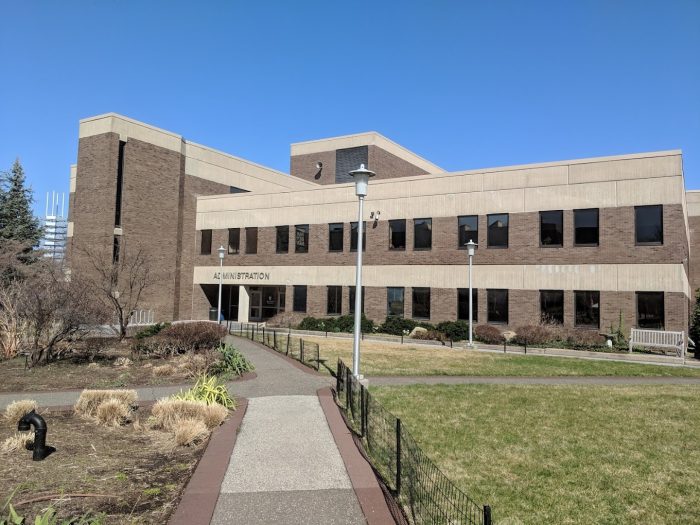
By Daniel Dunaief
For Stony Brook University, 2024 will be the year of more, as in more college counselors, more classes, more study abroad opportunities, more artificial intelligence and more faculty.
The downstate flagship university, which is a member of the Association of American Universities and has been climbing the rankings of colleges from US News and World Reports, plans to address several growing needs.
“We have invested heavily in new advisors,” said Carl Lejuez, executive vice president and provost at Stony Brook, in a wide ranging interview. These advisors will be coming on board throughout the semester.
With additional support from the state and a clear focus on providing constructive guidance, the university is working to reduce the number of students each advisor has, enabling counselors to “focus on the students they are serving,” Lejuez said.
Advisors will help students work towards graduation and will hand off those students to an engaged career center.
At the same time, Stony Brook is expanding its global footprint. Lejuez said study abroad options were already “strong” in Europe, while the university is developing additional opportunities in Asia and Africa.
The university prioritizes making study abroad as affordable as possible, offering several scholarships from the office of global affairs and through individual departments.
Students aren’t always aware that “they can study abroad in any SBU-sponsored program for a semester and keep all of their existing federal aid and scholarships and in many cases the full cost of that semester abroad is comparable and sometimes even less expensive” than what the student would spend on Long Island, Lejuez explained in an email.
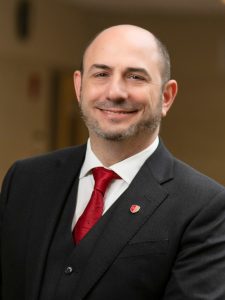
As for artificial intelligence, Stony Brook plans to expand on existing work in the realm of teaching, mentoring, research and community outreach.
In efforts sponsored by the Center for Excellence in Learning and the Library, the university is holding multiple training sessions for faculty to discuss how they approach AI in their classrooms.
The library opened an AI Lab that will enable students to experiment, innovate and work on AI projects, Lejuez said. The library plans to hire several new librarians with expertise in AI, machine learning and innovation.
The library is training students on the ethical use of AI and will focus on non-STEM disciplines to help students in the arts, humanities and social sciences.
Artificial intelligence “has its strengths and weaknesses,” said Lejuez. “We are not shying away from it.”
As for the community, the hope is that Stony Brook will use the semester to develop plans for kindergarten through 12th grade and then launch the expansion later this spring.
Additional classes
Lejuez acknowledged that class capacity created challenges in the past.
Stony Brook is using predictive analysis to make decisions about where to add classes and sections. At this point, the university has invested in the most in-demand classes in fields such as computer science, biology, chemistry, psychology and business.
The school has also added capacity in writing, math and languages.
Stony Brook is focused on experiential opportunities across four domains: study abroad, internships, research and entrepreneurship.
The school is developing plans for additional makerspaces, which are places where people with shared interests can come together to use equipment and exchange ideas and information.
New hires
Stony Brook is in the middle of a hiring cycle and is likely to “bring the largest group of new faculty we’ve had in many years” on board, the provost said. “This is going to have a big impact on the student experience” including research, climate science, artificial intelligence and healthy aging.
The additional hires will create more research experiences for undergraduates, Lejuez said.
Stony Brook recently created a Center for Healthy Aging, CHA, which combines researchers and clinicians who are focused on enhancing the health and wellness of people as they age.
Amid a host of new opportunities, a rise in the US News and World Report rankings and a victory in the city’s Governors Island contest to create a climate solutions center, Stony Brook has seen an increase in applications from the state, the country and other countries.
This year, about 10,000 students applied to Stony Brook’s first early action admissions process, which Lejuez described as a “great success.”
Amid a world in which regional conflicts have had echoes of tension and disagreement in academic institutions around the country and with an election cycle many expect will be especially contentious, Stony Brook’s Humanities Institute has put together several programs.
This includes a talk on “Muslim and Jewish Relations in the Middle Ages” on February 15th, another on “The Electoral Imagination: Literature, Legitimacy, and Other Rigged Systems” on April 17th and, among others, a talk on April 18th titled “The Problem of Time for Democracies.
True to the core values
Amid all the growth, Stony Brook, led by President Maurie McInnis, plans to continue to focus on its core values.
Lejuez said some people have asked, “are we still going to be the university that really provides social mobility opportunities in ways that are just not available in other places? We will always be that. Everything else happens in the context” of that goal.


